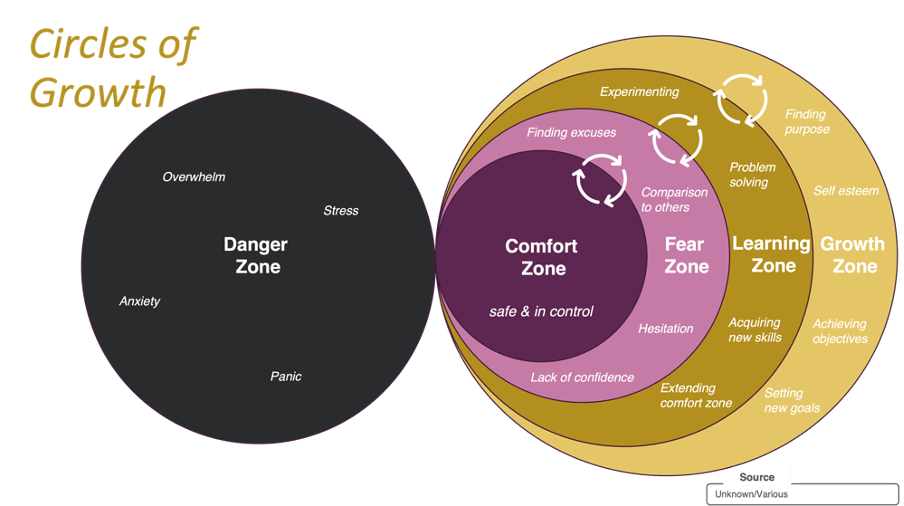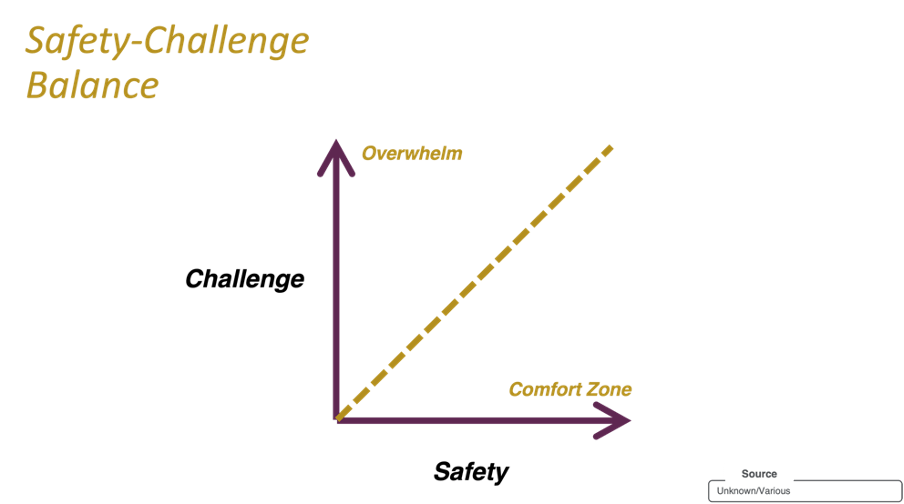We’ve probably all heard the term “growing pains” before, often used to describe the aching that children and young people have in their legs as their muscles accelerate rapidly is size and strength as part of their natural development process. As adults we might also feel muscular discomfort after a workout, as our muscles repair and get bigger and stronger. There’s “no gain without pain” is another commonly used term, and so we seem to know on some level that gain, growth, strength etc. can come with an element of pain or discomfort.
However, at the same time, it is also quite typical for us to want to avoid the pain and discomfort – because it’s uncomfortable! We can find ourselves moving into what might be called the “fear zone”, a fear of what we have to go through to achieve our goal or maybe a fear that we can’t achieve it. We procrastinate, hesitate, make excuses for our lack of action, and compare ourselves unfavourably to others, all of which can lead to even more uncomfortable feelings of lacking in confidence. All of this can be enough to see us running quickly back to the comfort zone again; we might rationalise our lack of action and justify staying in the current situation because “the devil you know” is better. We feel safe and in control again – fulfilling two of our primary human needs. This transition between comfort and fear can become a loop that cycles around and around, consuming our energy each time we move back and forth from one to the other, without actually getting anywhere.

So, how does this relate to coaching? When our clients bring a goal that they want to achieve or an issue they want to resolve, it presupposes that there is an element of change or challenge associated with this…otherwise why would they have brought it into coaching? If their current thoughts, feelings, and behaviours were enough and were working well, you probably wouldn’t be having the conversation with them. This means that a level of discomfort in coaching is almost inevitable. What, therefore, is needed from us when our clients step into that space of self-doubt, hesitation, rationalising, comparison and enter the fear zone?
This is where the safety-challenge balance comes in… we cultivate trust and safety with our clients so that the discomfort is normalized and becomes something that they can be with when in that space with you. We invite them to fully express their feelings so that they feel heard and supported without judgement. We encourage them to remember how they have been in places of discomfort before and how they managed to find strategies to move on from their difficult feelings into a place of forward movement and progress. We show support for them and highlight their strengths, talents, and insights.
We also challenge them… we invite them to consider if their concerns are actually real or are perhaps simply untested assumptions, we invite them to be playful and experimental with small steps, we offer them our observations when we notice negative or minimising language, we evoke awareness by inviting exploration of different ways of thinking or feeling about their situation, and we partner with them to contemplate new perspectives and possibilities.

So, which one do we start with in order to support our clients to move effectively through the fear zone and onto the learning and the growth zones? Safety first! By building a strong foundation of safety, and co-creating a relationship that is open, honest, and trusting, we provide a platform from which we can challenge our clients enough to catalyse a shift to the next level. Not only that, the stronger the safety is, the stronger the challenge can be, as we have a depth to our relationship which enables us to support our clients through some potentially very challenging issues or goals.
Striking this balance is key to how we can navigate these circles of growth for and with our clients. Too much support and not enough challenge, means that we will both stay in a comfort zone of inaction. Our conversations might be very friendly and ‘easy’, but they may not be effective in facilitating growth. Too much challenge and not enough support, and the client might feel catapulted into a danger zone of stress and overwhelm, paralysing them and then making them run straight back to the comfort zone for cover. As with the workout example, some pain and discomfort might be inevitable for growth, but going crazy in the gym could result in seriously injuring a muscle.
Finally, and equally important, is how might all of this also apply to us as coaches? How we engage with our clients from a ‘doing’ perspective is only half of the story. We need to check in with ourselves and how we are ‘being’: how comfortable are we with discomfort? Are we comfortable with not knowing? Are we comfortable with challenging our clients? Are we comfortable with evoking discomfort in them? Are we also doing our work as well as inviting our clients to do theirs?
Coach Advancement by Tracy Sinclair supports organisations to develop the potential of their people through coaching, coaching skills and coaching culture. Our Coaching with Conscience services specialise in offering coaching and coaching related services in support of positive social impact and social progress.

Tracy Sinclair is a multi-award-winning Master Certified Coach (MCC) with the International Coaching Federation (ICF). She is also a trained Coaching Supervisor, Mentor Coach and ICF Assessor. Tracy trains coaches and works with managers and leaders to develop their coaching capability. She works as an international Corporate Executive and Board Level Coach, a leadership development designer and facilitator working with a wide range of organisations. Tracy also specialises in working with organisations to support them develop coaching culture. Tracy has co-authored a book Becoming a Coach: The Essential ICF Guide published in 2020 which provides a comprehensive guide to coaching for coaches at all levels of skill and experience, the psychology that underpins coaching and the updated ICF Core Competency Model. In this same year she founded Coaching with Conscience which exists to have a positive impact on society and our environment through coaching. As part of this work, she collaborates closely with MIND, the UK’s leading mental health charity and the British Paralympic Association (BPA). She also offers pro bono personal development and coaching programmes to young leaders (18-25-yrs). Tracy was named as one of the Leading Global Coach winners of the Thinkers50 Marshall Goldsmith Awards of 2019 and was a finalist for the Thinkers50 Coaching and Mentoring Award in 2021. She won the ICF Impact Award for Distinguished Coach in 2023 and is a member of the Marshall Goldsmith 100 Coaches. She was the President of the UK ICF from 2013-2014 and was an ICF Global Board Director since 2016, serving as Treasurer in 2017, Global Chair in 2018 and Immediate Past Global Chair in 2019 and Vice Chair and Director at Large on the International Coaching Federation Global Enterprise Board in 2021.
Share This Post!
Sign up for additional resources, opportunities and updates!
Delivered straight to your inbox.







